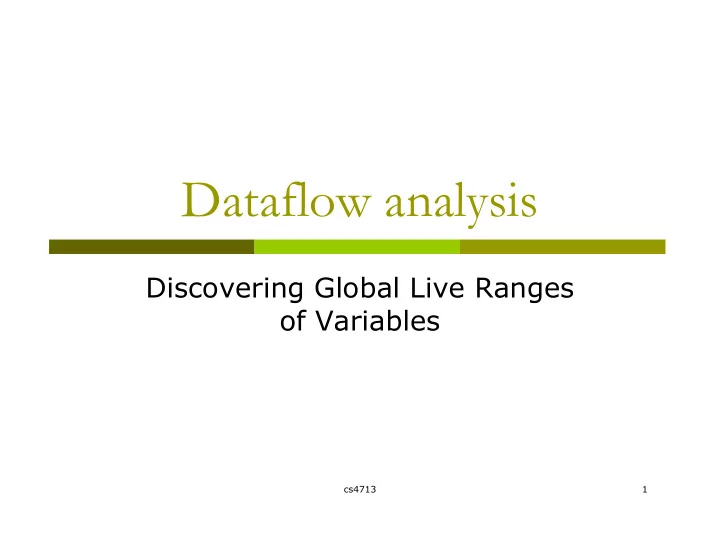

Dataflow analysis Discovering Global Live Ranges of Variables cs4713 1
Optimization and analysis Requirement for optimizations Correctness (safety) must preserve the meaning of the input computation Profitability must improve code quality Program analysis Statically examines input computation to ensure safety and profitability of optimizations Compile-time reasoning of runtime program behavior Undecidable in general due to external program input, complex control flow, and pointer/array references Conservative approximation of program runtime behavior: may miss opportunities of applying optimization, but ensure all optimizations are correct Data-flow analysis Reason about flow of values on control-flow graphs Example: available expression analysis for global redundancy elimination Can be used for program optimization or program understanding cs4713 2
Control-flow graph Graphical representation of runtime control-flow paths Nodes of graph: basic blocks (straight-line computations) Edges of graph: flows of control Useful for collecting information about computation Detect loops, remove redundant computations, register allocation, instruction scheduling… Alternative CFG: Each node contains a single statement i =0; …… i = 0 if I < 50 while (i < 50) { t1 = b * 2; a = a + t1; t1 := b * 2; i = i + 1; …… a := a + t1; } i = i + 1; …. cs4713 3
Live variable analysis A data-flow analysis problem A variable v is live at CFG point p iff there is a path from p to a use of v along which v is not redefined At any CFG point p, what variables are alive? Live variable analysis can be used in Global register allocation Dead variables no longer need to be in registers Useless-store elimination Dead variable don’t need to be stored back to memory Uninitialized variable detection No variable should be alive at program entry point cs4713 4
Computing live variables For each basic block n, let UEVar(n)=variables used before any definition in n VarKill(n)=variables defined (modified) in n (killed by n) for each basic block n:S1;S2;S3;…;Sk VarKill := ∅ M UEVar(n) := ∅ for i = 1 to k S1: m := y * z suppose Si is “x := y op z” S2: y := y -z if y ∉ VarKill S3: o := y * z UEVar(n) = UEVar(n) ∪ {y} if z ∉ VarKill UEVar(n) = UEVar(n) ∪ {z} VarKill = VarKill ∪ {x} cs4713 5
Computing live variables For each basic block n, m:=a+b A let n:=a+b B UEVar(n) q:=a+b vars used before defined p:=c+d C r:=c+d VarKill(n) r:=c+d vars defined (killed by n) Goal: evaluate vars e:=b+18 e:=a+17 alive on exit from n D s:=a+b E t:=c+d u:=e+f u:=e+f LiveOut(n)= ∪ m ∈ succ(n) (UEVar(m) ∪ v:=a+b (LiveOut(m) - VarKill(m)) F w:=c+d X:=e+f y:=a+b G z:=c+d cs4713 6
Algorithm: computing live variables For each basic block n, let UEVar(n)=variables used before any definition in n VarKill(n)=variables defined (modified) in n (killed by n) Goal: evaluate names of variables alive on exit from n LiveOut(n)= ∪ (UEVar(m) ∪ (LiveOut(m) - VarKill(m)) m ∈ succ(n) for each basic block bi compute UEVar(bi) and VarKill(bi) LiveOut(bi) := ∅ for (changed := true; changed; ) changed = false for each basic block bi old = LiveOut(bi) LiveOut(bi)= ∪ (UEVar(m) ∪ (LiveOut(m) - VarKill(m)) m ∈ succ(bi) if (LiveOut(bi) != old) changed := true cs4713 7
Iterative dataflow algorithm Iterative evaluation of result for each basic block bi sets until a fixed point is compute Gen(bi) and Kill(bi) reached Result(bi) := ∅ Does the algorithm always for (changed := true; changed; ) terminate? changed = false If the result sets are bounded and grow for each basic block bi monotonically, then yes; old = Result(bi) Otherwise, no. Result(bi)= Fixed-point solution is independent of evaluation ∩ or ∪ order [m ∈ pred(bi) or succ(bi)] What answer does the (Gen(m) ∪ (Result(m)-Kill(m)) algorithm compute? if (Result(bi) != old) Unique fixed-point solution changed := true The meet-over-all-paths solution How long does it take the algorithm to terminate? Depends on traversing order of basic blocks cs4713 8
Traversing order of basic blocks Facilitate fast convergence to the fixed point 4 Postorder traversal postorder 2 3 Visits as many of a nodes successors as possible before visiting the node 1 Used in backward data-flow analysis Reverse postorder traversal Visits as many of a node’s predecessors as possible 1 before visiting the node Used in forward data-flow 3 2 Reverse analysis postorder 4 cs4713 9
More about dataflow analysis Sources of imprecision Unreachable control flow edges, array and pointer references, precedure calls Other data-flow programs Reaching definition analysis A definition point d of variable v reaches CFG point p iff there is a path from d to p along which v is not redefined At any CFG point p, what definition points can reach p? Very busy expression analysis An expression e is very busy at a CFG point p if it is evaluated on every path leaving p, and evaluating e at p yields the same result. At any CFG point p, what expressions are very busy? Constant propagation analysis A variable-value pair (v,c) is valid at a CFG point p if on every path from procedure entry to p, variable v has value c At any CFG point p, what variables have constants? cs4713 10
Recommend
More recommend